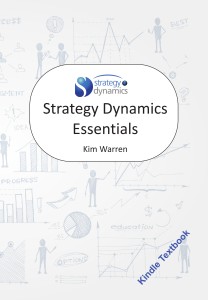Kim Warren on Strategy
Strategy insights and living business models
Strategy Dynamics Briefing 24: Resource quality: understanding attributes
The briefings up to this point have put together the basic elements of the simple core system of how an organization functions and delivers performance that changes over time. This picture with numerical information on its performance is often enough to see big improvement opportunities. However, there is much more opportunity to use strategy dynamics to improve performance…
Strategy Dynamics Briefing 23: Generic Architectures
The balanced scorecard has transformed the way in which organizations track and steer their performance, and is now a popular tool among large companies. (See Kaplan, R. and Norton, D. 1996. The Balanced Scorecard, Harvard Business School Press, Boston, MA. See also www.balancedscorecard.org.)
What important advances over traditional reporting approaches does it offer?
Strategy Dynamics Briefing 22: Generic architectures
Recent briefings have shown how mapping out, rigorously, the interdependence amongst resources results in a model of the ‘machine’ that makes the organization function and deliver performance, which we have called its strategic architecture…
After a short break over the summer, the briefings resume. Read on to find out more about Strategic Architectures.
Strategy Dynamics Briefing 21: The strategic architecture.
The last three briefings have gone into the issue of interdependence between resources, and have brought us to the point where we now have the essential elements needed to describe an entire business and its performance…
Read on to find out what they are, and examine a simple example of a business with several resources.
Strategy Dynamics Briefing 20: The Bass Diffusion Model
A particularly common framework arises when the saturation of a limited opportunity combines with word-of-mouth between already active customers and potential customers. This captures well how new products “diffuse” into a market, a process first set out by Professor Frank Bass hence the framework’s title. Read on to find out more…
Strategy Dynamics Briefing 19: Resources drive each others growth, or limit it
The flows in and out of a resource (the rates at which it grows or declines) depend on existing resources – more sales people should lead to customers being won more quickly, for example.
However there are two special cases of this dependency that are both very common and important… What are they?
Strategy Dynamics Briefing 18: Resources drive each others growth, or limit it
What makes strategy dynamics so powerful?
Read on to see how we wrap up the rock-solid theory behind strategy dynamics…
Strategy Dynamics Breifing 17: The problems with correlation
A devastating implication arises from the interdependency between resources from the previous briefing. For example, a simple story…
Strategy Dynamics Briefing 16: What drives gains and losses of resources?
We defined the first two parts of the core strategy dynamics framework by repeating relentlessly the question ‘what causes what?’ So the next logical question is… ‘What causes the rate at which resources are won and lost?’
Answering this question will define the final part of the theory and complete the core ‘strategic architecture’ for a business or other organization.
Strategy Dynamics Briefing 15: Insights from asking simple resource-flow questions
After all the years I have been using strategy dynamics, I still find myself shocked at the power of this most basic of questions!
Time after time, executives get completely new insights from asking about just three numbers! What are they?

